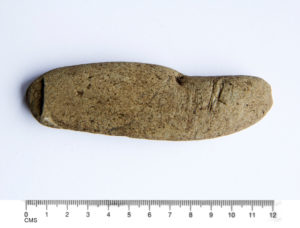Poster presented at 10th Conference for Hunter and Gatherer Societies (CHAGS) , Liverpool 2013.
Lithic Specialist


During recent excavations at Camas Daraich, Skye an incised bevelled pebble was discovered at the base of a midden layer dating to the Mesolithic . Finds of incised or decorated stone and bone from this period are rare in Britain as a whole and this is the first of its kind from Scotland.
This is a classic elongated pebble form with a double bevel worn on the broader end and with some flaking from this end too. The bevels abut to form a ridge which runs at an angle to the faces. The pebble has a naturally shaped ‘handle’ which is a third of the total length of the tool. The incised pattern is formed of pairs of narrow, parallel bands which divide the tool obliquely into thirds. For a 3D image of this tool check:
There are many possible interpretations for the presence of the incised lines on this stone tool. It is clear that the incisions are deliberate and composed but it cannot be determined yet whether they are, for example, purely functional, a deliberate abstract representation, a recording or message. A full discussion of the meaning behind the incisions is in:
Clarke, A; Vila, A; Estevez, J; Hardy, K 2012 ‘The Tie That Binds? An incised Mesolithic bevelled pebble from Camas Daraich, Skye’ Mesolithic Miscellany 22.1, October 2012, 3-9. https://sites.google.com/site/mesolithicmiscellany/journal-information/journal-volumes
Recent excavations at sites in Northern Britain have added to the repertoire of coarse stone tools known to have been in use during the Mesolithic. By analysing the distinctive wear traces on all the coarse stone tools from a site and by examining their context of deposition it has been possible to identify areas on site where specific activities were being carried out. Coarse stone tools appear to have been subject to some form of structured use and deposition and this appears in the archaeological record in three ways: by the dominance or single use of a particular tool type; by the presence of discrete deposits of tools; or by a combination of both. The evidence suggests that some sites were used for specific craft or processing activities over time, whilst other sites were used for multiple activities, perhaps related to repeated visits.
The full article is published as:
Clarke, A 2009 ‘Craft specialisation in the Mesolithic of Northern Britain: the evidence from the coarse stone tools’, in N Finlay; S McCarten; N Milner and CR Wickham-Jones 2009 From Bann Flakes to Bushmills, Oxbow and can be downloaded here:
https://www.academia.edu/7847739/Craft_specialisation_in_the_Mesolithic_of_northern_Britain_the_evidence_from_the_coarse_stone_tools